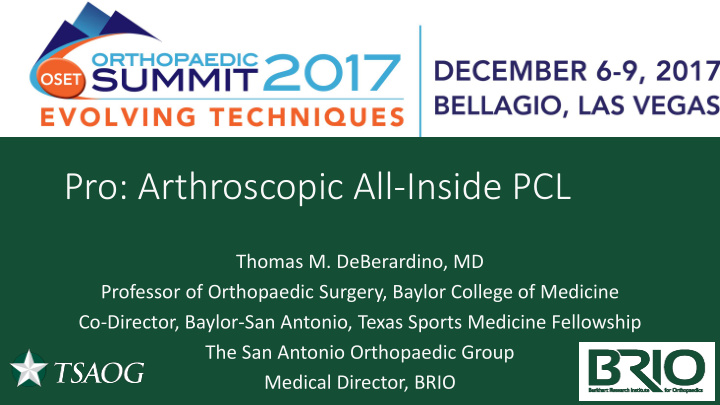



OSET Pro: Arthroscopic All-Inside PCL Thomas M. DeBerardino, MD Professor of Orthopaedic Surgery, Baylor College of Medicine Co-Director, Baylor-San Antonio, Texas Sports Medicine Fellowship The San Antonio Orthopaedic Group Medical Director, BRIO
Tibial & Femoral PCL Footprints Juxtaposed to posterior horn
PCL Graft Options • Inlay • Achilles • GraftLink • Tibialis • Peroneus Longus • ST • Tri-Link (all soft tissue)
Achilles Tendon Allograft • Achilles Tendon • Strong with large cross sectional area • No donor site morbidity • Fixation • Bone to bone • Tendon to bone • Easy graft passage- Inlay All-inside
PCL GraftLink Fixation • Cycle knee/pretension graft • Tibial fixation • PCL TightRope with ABS button • Femoral fixation • TightRope RT with FiberTag x 2 for AL & PM bundles
Tibial Inlay Technique • Advantages: • Disadvantages • Eliminates acute graft angle- • Technically demanding tibial? • Collateral ligament surgery • Easier graft passage (chamfer difficulty (open) bone plug) • Revision PCL surgery • Femoral side tensioning
Double Bundle Biomechanics
Dual Femoral Tunnel PCL • Recent techniques emphasized a more anatomic reconstruction by recreating PM & AL bundles • Cadaveric testing shows double bundle reconstruction better replicates native anatomy
Reasons for All-inside PCL • Less morbidity- drilling away v. toward N-V structures Cohen SB, Boyd L, Miller MD • Less bone removal (blind socket vs tunnel) J Knee Surg 2004; 23:381-393 • More exact socket placement and shape • Concomitant surgery easier • Shorter procedure benefits all involved • Less incision complications (longest incision- 1 cm) • …potential less risk of infection • It was only a matter of time and the natural progression of the procedure
Arthroscopic vs Open Inlay • Arthroscopic double-bundle PCL inlay reconstruction provides comparable stability to the open approach with a potential for lower operative morbidity Mark Miller et al. Arthroscopy 24;4:472-480, April 2008
Location, Location, Location! • Any ligament reconstruction (PCL, ACL, LCL, etc.) requires exact placement of grafts to BEST reproduce normal anatomy • What better way to be DEAD ON with sockets than to Start the tunnels where the typical surgery Tries to finish • All-inside drilling IS the way to go– antegrade or retrograde
Current Technique: Graft Prep • Entire width of Achilles allograft • Manually split tendon for AL & PM bundles 9mm • Keyhole saw to make 12mm diameter plug 9mm Keyhole saw @ proximal edge to control depth
Graft Prep • Central drill hole • ABS secured with #2 Fiberwire sutures • #2 Fiber- TigerLoop sutures for free ends of AL and PM
Arthroscopic Approach • Posterior Medial Portal- if needed • Thorough debridement of the PCL tibial facet • Be mindful of the posterior horns of both menisci
Socket Preparation • Use FlipCutter of equal to size of Coring Reamer used for graft preparation • Drill socket slightly deeper than bone plug (12-15mm for 10mm plug)
Tibial Socket Prep Right knee • Identify over the top position • Confirm with mini C-arm • Size: 12-13 mm with Flip Cutter • Depth: 20 mm
Tibial Socket Prep Right knee • Shaver removes debris • View from posteromedial portal to insure socket cleared • Place passing suture
AL & PM Femoral Socket Prep • AL drilled 1 st • Passing sutures • PM drilled 2 nd • Passing sutures placed • Leave 7mm cortical rim
Graft Passage
Graft Fixation PCL Tightrope w/ ABS
Final AIDB PCLR
AIDB Achilles PCL Inlay Graft with PCL TightRope and AL/PM TightRope RT
Final AIDB Achilles PCL Inlay Graft
All-Inside PCL Advantages • Bone Preserving • Safe & Reproducible • Graft Reinforcement • Easy graft passage – no “killer turn” • Secure cortical suspensory fixation
Graft Passing – Tibia First *Marketing materials such as medical illustrations, product photos, brochures, videos, animations and techniques are the property of Arthrex and may only be shared for educational purposes (PowerPoint presentations, articles submissions, textbooks, etc.). Arthrex does not provide marketing materials to other websites including distributor or surgeon websites”.
Graft Passing – Femur Second Tension Note: a probe or holding suture are needed to provide tension for button seating and graft advancement
Final Tensioning Tie both sets • Add the 14 mm or ABS Button to TightRope exiting the tibial socket • Load the whipstitched sutures onto the button • Flex knee to 80 degrees • Tension the graft and recreate the normal anterior tibial “step-off” • Pull on each shortening stand in 1cm increments Load the Whipstitched sutures
PCL GraftLink • PROS • Surgeons Familiar with ACL GraftLink • No Convergence with ACL or MCL sockets, tunnels • No Bone Block to deal with!!
Thank You Questions?
Recommend
More recommend